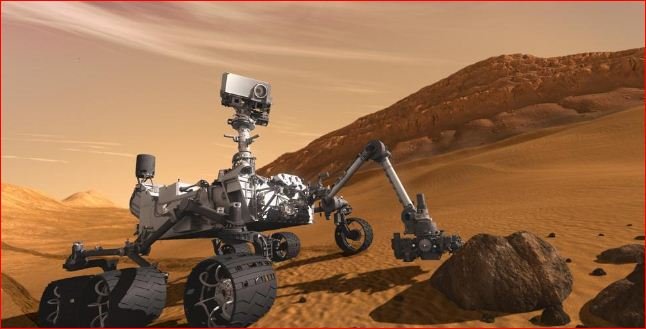The SUV Curiosity of NASA has discovered complex organic compounds on Mars rocks 3,500 million years old and has detected cyclical variations in the concentration of methane in the atmosphere of the red planet throughout the seasons. Although the results, published today in two articles in the journal Science, still do not allow to discern the source of these organic molecules, the researchers point out that both findings could have a biological origin.
Curiosity, which explores Gale’s crater since 2012, near the Martian equator, had already found signs of organic molecules in 2015, but the presence of chlorine compounds made the test unreliable. Now, he has analyzed new samples of clay rocks from the base of a mountain in the center of the Gale crater, extracted from a depth of five centimeters, with his SAM instrument (from the English Sample Analysis at Mars). By heating them to 820 degrees Celsius, the rocks have released a range of compounds in the form of gas, which, according to SAM analysis, indicate the presence of large organic molecules, such as those found in coal or oil.
There were many scientists who did not expect the SAM instrument to detect organic matter in rocks in Gale’s crater. And they had good reason to think that way, ” Jennifer Eigenbrode, a NASA astrobiologist and lead author of the study, explains by email. The radiation that reaches the surface of Mars, much higher than on Earth, produces a chain reaction that destroys organic matter. At the depth at which Curiosity obtains samples, it could be expected that no organic molecules remained. However, the presence of sulfur in Martian rocks seems to have conserved them, since among the compounds that SAM has identified, this element is abundant -sulfur is responsible for the hair and nails of animals, for example, is so durable -.
Our discovery helps us to better understand how organic matter is preserved on Mars and motivates us to look for more organic compounds that can provide evidence of life
3,500 million years ago, Mars was a planet very similar to Earth. In fact, scientists think that at that time the Gale crater was actually a lake of liquid water and, therefore, a habitable environment. The discovery of the Eigenbrode team now shows that at that time there were also organic compounds that could have fed living beings.
However, the researchers warn that the organic matter in Gale’s crater does not have to be related to life. The hostile conditions of the Martian surface have degraded the compounds to such an extent that it is impossible to know if one day they were part of living beings, explains Eigenbrode. On the other hand, the molecules could have been generated by geological processes or have reached Mars aboard meteorites.
“Our discovery helps us to better understand how organic matter is preserved on Mars and motivates us to look for more organic compounds that can provide clues to life,” says Jennifer Eigenbrode. The hopes of the researchers are placed in the next SUVs that NASA and the European Space Agency (ESA for its acronym in English) will send to the red planet: Mars 2020 and ExoMars. Both will be prepared to analyze samples of rocks that are deeper or more exposed to the surface more recently, and that could be better preserved.
The concentration of methane increases in the equinoxes, in spring and autumn, and decreases in the solstices, in summer and winter
On the other hand, Curiosity’s SAM instrument has also made ten measurements of the concentration of methane in the atmosphere over almost three Martian years, equivalent to five terrestrial ones. Although the concentration of the gas is very small, it undergoes vertiginous variations throughout the seasons: it increases in the equinoxes, in spring and autumn, and decreases in the solstices, in summer and winter. At the point of greatest abundance, the concentration of methane in the atmosphere is multiplied by three. “It’s totally unexpected,” Christopher Webster, a researcher at NASA’s Jet Propulsion Laboratory (JPL) and lead author of the work, told a NASA press conference.
This seasonal pattern has surprised scientists, who for the moment have no hypothesis that can explain it. “The origin of the methane cycle, for now, is unknown,” Daniel Viúdez-Moreiras, co-author of the study and researcher at the Center for Astrobiology (CSIC-INTA) , who participates in the Curiosity mission with the monitoring instrument, said in a telephone interview. of the REMS climate (from the English Rover Environmental Monitoring Station). “One of the possibilities is that methane has biological origins, but today it is impossible to know,” he says. On Earth, there are microorganisms that generate this gas as a product of their metabolism; they live, for example, in our intestine and that of other animals.
However, according to Viúdez, there are other more plausible origins: one of them is that the methane was trapped under the subsurface of Mars in the past, when gas was abundant in the atmosphere. It would be embedded within compounds called clathrates, which in the current conditions of the planet would let it escape slowly. However, the cycle that Curiosity has detected “does not completely fit this hypothesis, since the emission of methane by clathrates should be more or less constant throughout the year, so there must be some other physical or chemical mechanism that is regulating the emissions, “says Daniel Viúdez-Moreiras.
One of the possibilities is that methane has biological origins, but to this day it is impossible to know
Another possibility is that it is generated from a mineral called olivine, abundant on Mars, by reacting with liquid water and carbon dioxide, which would mean that there would be liquid water in the subsoil of Mars. It could also be that, at least in part, it is produced from the degradation of organic matter that arrives in meteorites that impact the Martian surface. But, again, these processes alone do not explain the cycles throughout the year. And neither do other seasonal parameters measured by Curiosity’s REMS instrument.
[wp_ad_camp_3]Daniel Viúdez-Moreiras hopes that the data provided by the ExoMars Trace Gas Orbiter (TGO), of the ESA and the Russian Space Agency (Roscosmos), will help to clarify this enigma. “One of the main scientific objectives of TGO is precisely to measure methane in the atmosphere of Mars with unprecedented precision,” the researcher points out. The probe has recently been placed in the orbit that will allow it to carry out its mission and it is expected that the first results will arrive between the end of this year and the beginning of the next
 MobiTechInfo
MobiTechInfo








